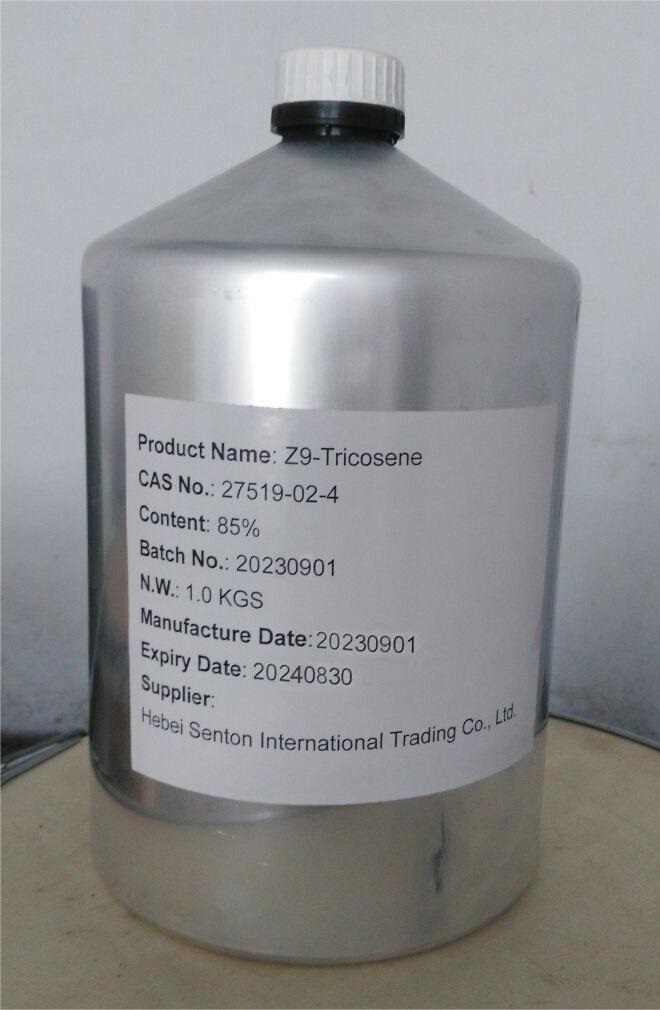Introduction:
TRICOSENE, a powerful and versatile biological pesticide, has gained significant attention in recent years due to its effectiveness in controlling pests. In this comprehensive guide, we will delve into the various usages and precautions associated with Tricosene, shedding light on its unique properties and ensuring a thorough understanding of its application. Whether you are a seasoned farmer, a horticulturist, or simply interested in the world of pesticides, this article aims to provide valuable insights regarding Tricosene.
1. Understanding Tricosene:
Tricosene, also known as (Z)-9-tricosene, is a pheromone-based insecticide compound derived from natural sources. This organic compound, primarily produced by bees, plays a crucial role in their communication and foraging behavior. Recognized for its remarkable effectiveness, Tricosene has been adopted for pest control purposes, targeting various insects such as cockroaches, ants, and silverfish.
2. Broad Applications:
Tricosene finds extensive usage across multiple sectors, including agriculture, household pest control, and public health. Its versatility is evident in its effectiveness in controlling common agricultural pests, managing infestations in residential or commercial properties, and even in controlling disease-carrying insects.
3. Agricultural Usage of Tricosene:
As a biological pesticide, Tricosene offers farmers an eco-friendly alternative to traditional chemical treatments. Its application in agriculture involves both prevention and eradication strategies. By strategically placing Tricosene-based traps or dispensers near crops, pests are effectively lured, reducing crop damage. Furthermore, research shows potential in mass trapping methods for higher efficiency.
4. Household Pest Control:
Tricosene’s non-toxic nature makes it an attractive option for addressing household pest issues while minimizing health risks to residents. Introducing Tricosene-based baits and traps helps control the population of common household pests such as cockroaches or ants, effectively reducing infestations.
5. Public Health Considerations:
Tricosene’s significance in public health lies in its ability to control disease-carrying insects like mosquitoes. By disrupting mating patterns and reducing insect populations, the risk of vector-borne diseases such as malaria, dengue fever, and Zika virus transmission can be mitigated. Tricosene-based mosquito traps and lures have proven to be efficient tools in safeguarding public health.
Precautions when Using Tricosene:
1. Proper Application Techniques:
To ensure optimum results, it is crucial to follow the recommended application techniques and guidelines available for Tricosene. This includes adherence to dosage instructions, correct placement of traps or lures, and appropriate timing for effective pest control.
2. Environmental Impact:
While Tricosene is considered an environmentally friendly alternative, caution must be exercised to prevent unintended consequences. Avoiding excessive application and ensuring targeted usage can help minimize non-target species exposure and protect beneficial insects.
3. Proper Storage and Disposal:
To maintain Tricosene’s stability and efficacy, it is essential to store it under suitable conditions, away from extreme temperatures and direct sunlight. When disposing of unused Tricosene or its containers, follow local regulations to protect both human health and the environment.
4. Safety Measures:
Always prioritize personal safety when handling Tricosene. Wear protective clothing, gloves, and masks when necessary, particularly when dealing with concentrated forms. Keep Tricosene out of reach of children and pets.
Conclusion:
In conclusion, Tricosene offers an effective and eco-friendly solution for pest control across various domains. Its diverse applications, ranging from agriculture to public health, highlight its versatility. However, it is crucial to follow recommended precautions and employ responsible usage to maximize efficacy while minimizing potential risks. Understanding the potential of Tricosene and its associated precautions will enable users to harness its benefits in a safe and responsible manner.
Post time: Oct-19-2023




